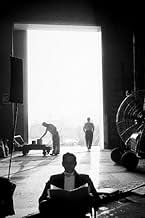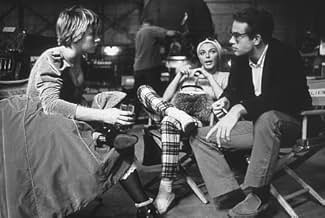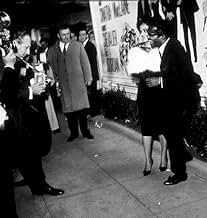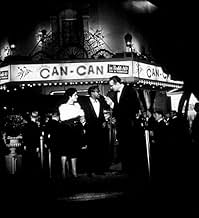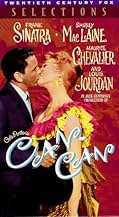VALUTAZIONE IMDb
6,3/10
2643
LA TUA VALUTAZIONE
Aggiungi una trama nella tua linguaIn 1896 Paris, a female nightclub proprietor fights against the forces of public morality for the right to feature her performers doing the risqué dance, the Can-Can.In 1896 Paris, a female nightclub proprietor fights against the forces of public morality for the right to feature her performers doing the risqué dance, the Can-Can.In 1896 Paris, a female nightclub proprietor fights against the forces of public morality for the right to feature her performers doing the risqué dance, the Can-Can.
- Regia
- Sceneggiatura
- Star
- Candidato a 2 Oscar
- 5 vittorie e 7 candidature totali
Frank Baker
- Party Guest
- (non citato nei titoli originali)
Benjie Bancroft
- Club Patron
- (non citato nei titoli originali)
Herman Belmonte
- Waiter
- (non citato nei titoli originali)
Shirley Blackwell
- Townsfolk
- (non citato nei titoli originali)
Eugene Borden
- Police Officer Chevrolet
- (non citato nei titoli originali)
Buddy Bryan
- Dancer
- (non citato nei titoli originali)
Carole Bryan
- Gigi
- (non citato nei titoli originali)
Recensioni in evidenza
I was all set to dislike "Can-Can" for a variety of reasons (not the least of which is Frank Sinatra cast in a musical set in 1896 France...Frank Sinatra??), but the film is a lot of fun. Sinatra and Shirley MacLaine are in good spirits throughout this pleasing adaptation of the stage-success about a dance-hall proprietress who defends her right to perform the scandalous title-named dance, deemed lascivious in its day. It runs a little too long, and MacLaine is more comfortable in her love scenes with Ol' Blue Eyes than with Louis Jourdan (who doesn't match up well with Shirley at all--he looks puny next to her), but otherwise it's surprisingly enjoyable and Juliet Prowse gives her small part as a dancer a great deal of zest. **1/2 from ****
The performers do not sing Cole Porter the way the best of singers can sing Cole Porter. Doris Day in "Lullaby of Broadway" sings "Just one of those things" wearing a tuxedo in a way that outshines Maurice Chevalier. Bob Hope singing "You do something to me" excels in a way that Louis Jordan cannot. Frank Sinatra and Shirley McClain singing "Let's do it" ends up as tepid as it gets as compared to almost anyone else's rendition. That these are all masters of the singer's craft makes for an astounding realization--the knack for singing a Cole Porter song is not for everyone or for every vehicle. One wonders how other singers handle interpretation of these songs in the same play. The movie was disappointing because the performances were disappointing.
Shirley MacLaine is a delight as the owner/operator of an 1895 Paris Night Club. The problem: A new, "disgusting" dance craze called the "Can Can" has swept Paris, and Shirley's night club seems to be the only place that dares to perform it nightly. Money man Frank Sinatra, who also is the on-again-off-again fiancé of the owner, attempts to bribe the authorities to turn a blind eye to what's going on at the club. Law man Louis Jourdan also falls for Shirley, while an ever-wise Maurice Chevallier tries his best to play cupid.
The musical numbers are wonderful, especially Shirley MacLaine's solo "Come Along With Me", The MacLaine/Sinatra duet "Let's Do It" and the grand finale "Can Can". -- This film cost 6 million dollars to produce, which was a lot in 1960. I'm glad they went through with it, because this is one of my favorite film musicals. They don't come much better than this!
The musical numbers are wonderful, especially Shirley MacLaine's solo "Come Along With Me", The MacLaine/Sinatra duet "Let's Do It" and the grand finale "Can Can". -- This film cost 6 million dollars to produce, which was a lot in 1960. I'm glad they went through with it, because this is one of my favorite film musicals. They don't come much better than this!
Strangely enough, the weakest aspect of this musical is the quality of the songs. Most of them are fairly mediocre, and fail to stay in the memory for long. But otherwise, "Can-Can" is a smashing entertainment. Lavishly produced and gorgeously photographed, this is one expensive movie where the money were spent with care and taste (unlike, for example, "Gentlemen Prefer Blondes" which, despite its big budget, looked cheap). The story may be a little thin, but it's suspenseful, too: you can never predict with absolute certainty if MacLaine will choose Sinatra (who is wonderful) or Louis Jourdan (who is as sly and charming as he was when he played the villain in "Octopussy"). But above everything else, this movie is a feast for the eyes!
This is another film which was often shown on TV (twice on the local channel alone!) but I hadn’t bothered with until now; it’s recently been released as a 2-Disc Set by Fox but, in view of its middling reputation, opted to acquire the film by itself.
To begin with, the DVD presentation had its good and bad points: the film was made available in its “Roadshow Version” – running 142 minutes against the “General Release Version” which eliminated 11 minutes of extraneous music (Overture, Intermission, Entr’ Acte and Exit Music); unfortunately, time seems to have taken its toll on the negative as there were several instances of color fluctuation throughout! As can be surmised, I decided to give the film a whirl as part of my ongoing marathon to commemorate the 10th anniversary from the passing of its male lead – Frank Sinatra; curiously enough, given his reputation as one of the foremost American singers, he appeared in few vintage musicals over the years…and it’s certainly a tribute to his acting talent that his non-musical work (often in hard-hitting, even groundbreaking films) has tended to overshadow this more familiar aspect of his personality – at least on the silver screen!
Anyway, to get back to the film proper: I found it quite engaging and its considerable length not overly taxing – and this, to a large degree, is thanks to the formidable star cast (which, apart from Sinatra, included Shirley MacLaine, Maurice Chevalier and Louis Jourdan). The first two had already appeared together – albeit in dramatic roles – in SOME CAME RUNNING (1958), while the others had been wonderfully teamed in the same genre and a similar ambiance in GIGI (1958). Ironically, both these films were helmed by a master stylist – Vincente Minnelli…so, perhaps, Fox should have struck a deal with MGM to acquire his services for CAN-CAN – but, given director Lang’s previous musical success with THE KING AND I (1956), they obviously thought he could do no wrong. The fact is that his handling is sterile and more accommodating to the Widescreen ratio than the necessities of the plot and characters – filming events from a distance and rarely cutting or even moving the camera; this lazy approach (which still landed him a nomination from the Directors' Guild Of America!) is doubly frustrating when viewed on a small screen!!
Apparently, the production went through a lot of script changes (Sinatra’s role, reportedly, wasn’t even in the stage original to begin with!), songs were dropped and replaced by other Cole Porter standards which don’t really fit in (such as Jourdan’s “You Do Something To Me”); the rest of the soundtrack isn’t particularly outstanding (unlike that of GIGI, for instance) but a number of tunes are cleverly reprised (sometimes with variations and by different characters) during the course of the film. It was nice, too, seeing two world-renowned singers with such different styles as Sinatra and Chevalier come together (and having fun with it); Chevalier and Jourdan’s roles, then, are virtual carbon copies of their GIGI characterizations – but it’s a formula that seems to work (even if it’s not as central to the main plot this time around, Jourdan having been relegated to The Other Man type).
MacLaine did few musicals as well but her vivaciousness (as a dancer and owner of an establishment which finds itself frequently in trouble with the law over the forbidden “Can-Can” dance, but who manages to charm the stuffy judge at the trial) ensures that her numbers emerge as the show’s highlights: the Apache Dance, the drunken recital of a vulgar song at her engagement party to Jourdan (at the instigation of lawyer Sinatra, who loves her but is unwilling to commit himself) and the “Garden Of Eden” sequence (intended to demonstrate that “Sin wasn’t invented in Montmartre – it was only perfected there”!). Two other important figures (though both severely underwritten) are those played by Juliet Prowse and Frenchman Marcel Dalio as the nervous but devoted manager of the “Bal De Paradis” (the latter was a versatile actor in his native land, but he was stuck with this kind of unrewarding role during his long tenure in Hollywood!); the former appears as a leading dancer at the club and MacLaine’s prospective rival – interestingly, the two actresses’ physiognomies are strikingly similar – for Sinatra’s attentions (a situation which is indirectly played upon during the afore-mentioned “Garden Of Eden” number, apart from which they’re teamed for the climactic Can-Can performance…to the predictable enthusiasm of the formerly disapproving head of a female Legion Of Decency-type group).
In the end, while this film can’t be considered a classic musical as such, it still seems to me to have been unfairly maligned – as some fantastic talent has been assembled in the service of a charming (albeit unsurprising) narrative to provide colorful (if uninspired) entertainment which the genre was capable of during its studio-system heyday…
To begin with, the DVD presentation had its good and bad points: the film was made available in its “Roadshow Version” – running 142 minutes against the “General Release Version” which eliminated 11 minutes of extraneous music (Overture, Intermission, Entr’ Acte and Exit Music); unfortunately, time seems to have taken its toll on the negative as there were several instances of color fluctuation throughout! As can be surmised, I decided to give the film a whirl as part of my ongoing marathon to commemorate the 10th anniversary from the passing of its male lead – Frank Sinatra; curiously enough, given his reputation as one of the foremost American singers, he appeared in few vintage musicals over the years…and it’s certainly a tribute to his acting talent that his non-musical work (often in hard-hitting, even groundbreaking films) has tended to overshadow this more familiar aspect of his personality – at least on the silver screen!
Anyway, to get back to the film proper: I found it quite engaging and its considerable length not overly taxing – and this, to a large degree, is thanks to the formidable star cast (which, apart from Sinatra, included Shirley MacLaine, Maurice Chevalier and Louis Jourdan). The first two had already appeared together – albeit in dramatic roles – in SOME CAME RUNNING (1958), while the others had been wonderfully teamed in the same genre and a similar ambiance in GIGI (1958). Ironically, both these films were helmed by a master stylist – Vincente Minnelli…so, perhaps, Fox should have struck a deal with MGM to acquire his services for CAN-CAN – but, given director Lang’s previous musical success with THE KING AND I (1956), they obviously thought he could do no wrong. The fact is that his handling is sterile and more accommodating to the Widescreen ratio than the necessities of the plot and characters – filming events from a distance and rarely cutting or even moving the camera; this lazy approach (which still landed him a nomination from the Directors' Guild Of America!) is doubly frustrating when viewed on a small screen!!
Apparently, the production went through a lot of script changes (Sinatra’s role, reportedly, wasn’t even in the stage original to begin with!), songs were dropped and replaced by other Cole Porter standards which don’t really fit in (such as Jourdan’s “You Do Something To Me”); the rest of the soundtrack isn’t particularly outstanding (unlike that of GIGI, for instance) but a number of tunes are cleverly reprised (sometimes with variations and by different characters) during the course of the film. It was nice, too, seeing two world-renowned singers with such different styles as Sinatra and Chevalier come together (and having fun with it); Chevalier and Jourdan’s roles, then, are virtual carbon copies of their GIGI characterizations – but it’s a formula that seems to work (even if it’s not as central to the main plot this time around, Jourdan having been relegated to The Other Man type).
MacLaine did few musicals as well but her vivaciousness (as a dancer and owner of an establishment which finds itself frequently in trouble with the law over the forbidden “Can-Can” dance, but who manages to charm the stuffy judge at the trial) ensures that her numbers emerge as the show’s highlights: the Apache Dance, the drunken recital of a vulgar song at her engagement party to Jourdan (at the instigation of lawyer Sinatra, who loves her but is unwilling to commit himself) and the “Garden Of Eden” sequence (intended to demonstrate that “Sin wasn’t invented in Montmartre – it was only perfected there”!). Two other important figures (though both severely underwritten) are those played by Juliet Prowse and Frenchman Marcel Dalio as the nervous but devoted manager of the “Bal De Paradis” (the latter was a versatile actor in his native land, but he was stuck with this kind of unrewarding role during his long tenure in Hollywood!); the former appears as a leading dancer at the club and MacLaine’s prospective rival – interestingly, the two actresses’ physiognomies are strikingly similar – for Sinatra’s attentions (a situation which is indirectly played upon during the afore-mentioned “Garden Of Eden” number, apart from which they’re teamed for the climactic Can-Can performance…to the predictable enthusiasm of the formerly disapproving head of a female Legion Of Decency-type group).
In the end, while this film can’t be considered a classic musical as such, it still seems to me to have been unfairly maligned – as some fantastic talent has been assembled in the service of a charming (albeit unsurprising) narrative to provide colorful (if uninspired) entertainment which the genre was capable of during its studio-system heyday…
Lo sapevi?
- QuizIt is explained in the film that the can-can was considered a lewd and lascivious dance (in reality often performed without panties).
- BlooperAbout 34 minutes in, when Philipe tries to close the window in Simone's boudoir, the whole wall shakes as he struggles with the window, indicating that it is a set wall and not a real building.
- Citazioni
François Durnais: You look like a broken umbrella.
- Curiosità sui creditiOpening credits prologue: Montmartre-1896
- ConnessioniFeatured in 20th Century-Fox: The First 50 Years (1997)
- Colonne sonoreI Love Paris
(uncredited)
Music by Cole Porter
Lyrics by Cole Porter
Sung by chorus over the beginning and end credits
I più visti
Accedi per valutare e creare un elenco di titoli salvati per ottenere consigli personalizzati
- How long is Can-Can?Powered by Alexa
Dettagli
- Data di uscita
- Paese di origine
- Sito ufficiale
- Lingue
- Celebre anche come
- Jack Cummings' Production of Cole Porter's Can-Can
- Luoghi delle riprese
- Parigi, Francia(stock footage of the evening barge sequences)
- Azienda produttrice
- Vedi altri crediti dell’azienda su IMDbPro
Botteghino
- Budget
- 6.000.000 USD (previsto)
- Tempo di esecuzione2 ore 11 minuti
- Proporzioni
- 2.20 : 1
Contribuisci a questa pagina
Suggerisci una modifica o aggiungi i contenuti mancanti





